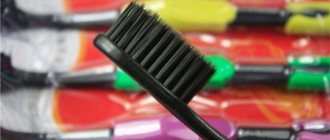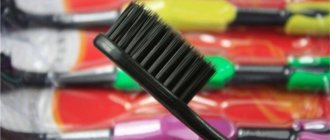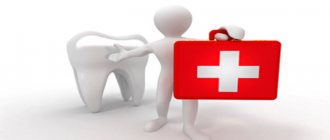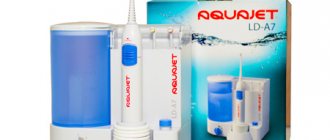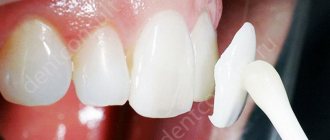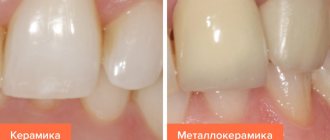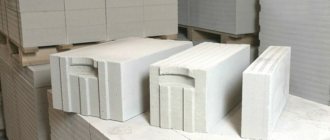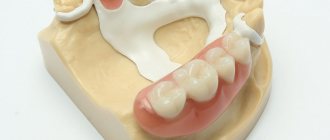Coagulation is used in dental practice in the treatment of both benign and malignant tumors. Using a coagulation apparatus, the specialist excises the tumor with the highest level of accuracy. The patient does not feel pain and does not experience psychological discomfort at the sight of a surgical instrument.
Laser gum excision
What is gum coagulation in dentistry?
The procedure is otherwise called cauterization. In dental practice, it is used mainly for excision of excess gums. It is similar to gingivectomy, but less traumatic. Using instruments that apply electric current or laser radiation, excess gum tissue is removed through coagulation - the sticking together of particles.
When exposed to high temperatures, protein and blood clot. Excess mucous membrane is cut off, the rest shrinks and becomes smaller. After the operation, the edges of the gums surrounding the tooth are aligned and become aesthetically pleasing.
The procedure is absolutely painless as it is performed under local anesthesia. There is no blood or risk of infection. The rehabilitation period is easy and short, as wounds heal quickly.
Unlike gingivoplasty, which can be used to close gum recession, it does not replace the missing tissue volume. Plastic surgery is primarily done to correct gingival contours and lift gums during atrophy.
How does the procedure work?
Coagulation of the gums is carried out by a dental surgeon under local anesthesia. The coagulation procedure (especially using a laser) is almost painless, so a special anesthetic gel is sufficient for complete pain relief.
During the operation, the patient must sit quietly in a chair - sudden movements can damage healthy tissues of the oral mucosa. Using a laser or coagulator, the doctor excises the required areas of tissue. If we are talking about a neoplasm, then it is completely removed.
The entire operation lasts on average 10-20 minutes - the duration directly depends on the method and complexity. For several hours after coagulation, you should not eat hard or hot food, which can further injure the wound. It is also necessary to maintain oral hygiene. For quick healing, it is recommended to rinse your mouth with soothing infusions (oak bark, chamomile, etc.).
Types of coagulation
The operation is performed using two devices: an electrocoagulator or a laser. Using a heated metal tool is an outdated but possible method. Laser therapy is more gentle compared to its predecessors.
Cauterization of gums in dental clinics is carried out using two methods:
- Monopolar. It is performed using an electrical device - a monopolar coagulator. Alternating current with high-frequency oscillations is supplied to the electrode, and through it into the tissue. It then passes through the body and returns to the end plate. In this case, coagulation occurs in a certain area. The procedure is safe and does not have a negative effect on the body.
- Bipolar. The tip of the electrocoagulator is bifurcated and does not have a closing plate. The current only affects the tissue sandwiched between the two ends that supply the electricity.
The bipolar technique is simpler and safer, but can only be used to remove small formations. Monopolar is suitable for all cases, but carries some risks. A burn may occur due to equipment malfunction or medical error. However, modern clinics are equipped with good equipment and experienced doctors, so you should not be afraid of the procedure.
What is a diathermocoagulator
With the help of diathermocoagulators, bleeding from small vessels is stopped, and tissue dissection is also carried out. There are many options for devices of this type on the medical equipment market. For example, DKS-30 is more often used in dentistry, DKH-250 is intended for electrosurgeons, and DKU-60 is positioned by the manufacturer as a universal model.
The structure and functionality of models from different manufacturers may vary slightly, but they all have much in common. Any diathermocoagulator is actually the device itself with a power control function, electrodes and a set of different attachments (blades, loops, electric knives).
Diathermocoagulation devices can be stationary or portable. If surgery is to be performed on a large area of the body, then a special type of device is used - a spray coagulator. With its help, an electric arc is created above the working surface, under which, in fact, a cut is formed. Diathermocoagulators are electrosurgical and argon. The second equipment option, in addition to electricity, involves the use of argon. Thanks to the gas, a layer of plasma is created between the tip of the device and the tissue, which serves as a conductor and at the same time prevents the nozzle from sticking to the surface.
A diathermocoagulator can create both superficial and deep effects of high-frequency alternating current on tissue. This means that diathermocoagulation can be useful for the treatment of superficial wounds and skin lesions, as well as in the case of pathologies of internal tissues and organs. An example of the surface effect of a diathermocoagulator is the procedure for removing warts. When talking about the effect on internal organs, they most often mean cauterization of erosions on the cervix and genital warts, treatment of dysplasia and some other gynecological diseases.
Operating principle
The operating principle of the diathermocoagulator is based on the laws of physics. Or rather, the one that says that when exposed to high temperatures, organic proteins coagulate. The diathermocoagulator electrodes, thanks to electric current, heat up to a high temperature and upon contact with the body, cause coagulation - that is, the folding of proteins.
The electrosurgical effect of a diathermocoagulator is that the device produces a narrow stream of high-frequency current, which strongly heats biological tissue. When the current reaches certain levels, the tissue fluid at the point of contact is heated to such an extent that it turns into steam and ruptures the surface of the tissue. At such a high temperature, local protein folding begins - coagulation. This is the method used by surgeons to make that same bloodless incision in the tissue.
Under the influence of a diathermocoagulator, a kind of thrombus forms in the damaged vessel. After contact with high-frequency current, the inner and middle shells of the vessel fold and clog its lumen. Thus, you can quickly stop the flow of blood and relieve pain at the site of injury. It is this feature of the diathermocoagulator that makes it indispensable in surgery.
The use of the instrument requires high professionalism from the doctor performing the manipulation. The fact is that during the procedure it is extremely important to invest in a certain time frame and correctly determine the power of the electric current. If diathermocoagulation is carried out for too long or when the electric current is too high, there is a serious risk for the vascular system and internal organs. An incorrectly performed procedure can disrupt metabolic processes and cause many severe adverse reactions.
This is interesting: Effective methods of treating oral leukoplakia
Indications and contraindications
The operation is especially in demand for hypertrophic gingivitis. This is an inflammatory gum disease. If left untreated, soft tissue grows, covering the crown of the tooth. The gingival papilla, which is located between adjacent dental units, is most susceptible to hypertrophy.
Coagulation is carried out in the presence of:
- tissue hyperplasia in gingivitis and other diseases;
- neoplasms: hemangiomas, fibromas, warts;
- abnormalities of gingival tissue;
- periodontitis (root canal coagulation);
- inflammation in periodontal pockets during periodontitis;
- caries on the neck, tooth root.
The list of restrictions includes individual intolerance to electric current, acute infections, exacerbation of chronic diseases, terminal stages of diabetes mellitus or other endocrine disorders, severe pathologies of the heart and blood vessels.
What causes a defect?
The causes of gum loss can be divided into 3 groups:
- Traumatic . If the gums are rubbed by a poorly installed filling, crown or teeth in the area of malocclusion, the gums will gradually atrophy and shrink. Recession is caused by shocks and injuries, exposure to harmful substances, poor ecology, and bad habits. Pathology can develop due to incorrectly performed whitening - in the clinic or at home, or aggressive brushing with a hard toothbrush. Large, incorrectly made veneers also often lead to gum recession.
- Symptomatic. It may be a consequence of gum disease or metabolic disorders, disturbances in the functioning of the endocrine or hematopoietic systems.
- Physiological . The reason is the aging of the body and metabolic disorders.
Preparing for surgery
Before the procedure, professional oral hygiene is carried out: removing plaque, removing tartar. If there are concomitant diseases, the patient is referred for examination to specialized doctors. After eliminating contraindications, a treatment date is set.
Before visiting the doctor, you need to eat a hearty meal, since after dental procedures you cannot eat for several hours. It is recommended to quit smoking and alcoholic beverages the day before the procedure. Alcohol and nicotine have a bad effect on blood clotting.
How to perform gum cauterization
The operation is performed by a dental surgeon. The patient is anesthetized with local anesthetics. It is important to relax, as sudden movements will disturb the doctor.
Using an electrocoagulator or laser device, excess gingival tissue is excised and tumors are removed. The procedure time depends on the amount of work, but usually does not exceed a quarter of an hour.
To treat pulpitis or periodontitis, coagulation is carried out through the root canal. If the caries is located below the gum level, the tissue is coagulated to gain access to the affected area. In case of periodontal disease, coagulation of the contents of periodontal pockets is carried out.
Manipulation techniques
For diathermocoagulation, special devices and devices are used. The manipulation itself can be carried out in the following ways.
Processing with a heated tool
This method is quite old and is practically not used in modern dentistry. A spatula, plugger or dental trowel was used as a cauterization tool.
This made it possible to cut off small damaged tissues localized on the gums. In addition, a heated instrument could stop bleeding from blood vessels or cauterize minor mechanical damage to the oral mucosa.
This is interesting: Stomatophyt A - instructions for use, composition, dosage
Cauterization using an electrocoagulator
These are special devices for carrying out these manipulations. Today they are widespread in all dental clinics. They are produced stationary, portable, which operate in various modes.
The operating principle of these devices is based on the use of alternating electric current, which provides heating to a special electrode. The doctor thus performs a gingivectomy or gingivotomy.
Using a laser
This technology is the most advanced and most gentle. The laser provides virtually painless removal of any tumors.
The big advantage of using this technique is that after treatment the wound does not bleed and becomes completely sterile. Thus, the laser beam provides significant prevention of the possibility of infection. You can learn how lasers are used in dentistry by watching the video in this article.
Application of laser in dentistry
After treatment with the coagulation method, the wound surface is quickly regenerated. To completely turn off sensitivity, local anesthesia is required. It can be carried out using injections or aerosol irrigation, as required by the instructions.
Basic methods of influence
Diathermocoagulation is indispensable in the treatment of cervical caries or when it affects the basal areas. Although the procedure is simple, the doctor must have certain professional skills to provide effective treatment.
Additional anesthesia allows the operation to be performed efficiently and without psychological trauma for patients. The price of diathermocoagulation is another indicator of the popularity of the technique. The cost is insignificant and additional costs are required for preparation and the postoperative period.
In addition, dentists actively use coagulation to remove tumors on the soft tissues of the oral cavity. After manipulation, as a rule, there are no complications or relapses that occur during surgical interventions by other methods.
Doctors mainly use 2 coagulation techniques:
- Monopolar technology . The peculiarity is that the electric current passes through the entire patient like a cutting instrument. This method is used most often, as it provides treatment even for deep-lying tumors or removal of large ones. To successfully carry out the procedure, a return plate is placed on the patient’s body, which allows the electrical circuit to be established.
- Bipolar technology. In this case, the electric current does not pass through the entire body, but only a certain area of the body. It closes over a short distance, providing treatment for only minor dental problems. An endplate is not required for the manipulation.
Gum cauterization is performed for various periodontal diseases. During surgery, a very important point is the absence of injury to adjacent tissues. This helps to avoid additional possible complications. After coagulation, the patient must follow the doctor's recommendations. They will be individual in each case.
Recovery period
You are allowed to eat after 3-4 hours. On the first day, you can eat soft, cold or lukewarm foods. You need to chew on the opposite side.
Hygiene procedures are allowed to be carried out the next day, but with caution. It is recommended to rinse your mouth with antiseptics Chlorhexidine, Miramestin, Furacilin, and treat the mucous membranes in the operated area with Metrogyl-Denta gel. After 5 - 7 days, you can supplement the care with means to accelerate regeneration, for example, sea buckthorn oil.
Cost of gum coagulation
The price consists of several factors: the volume of the operation, cauterization method, equipment (laser device or electrical device), additional services. If there is plaque or tartar, then professional cleaning is required, which is paid separately. The price of cauterization for 1 tooth in Moscow is from 1000 rubles to 4000 rubles and more, depending on the complexity of the case.
Our clinic uses modern equipment and employs dental surgeons with extensive clinical experience. We guarantee painless, high-quality treatment and no complications. Prices are agreed upon with the patient before the operation.
Advantages and disadvantages
Of the two methods of electrical coagulation, biopolar is safer, but is not suitable for all cases. With its help, you can remove only small formations on the gums.
The monopolar method is more universal and is used most often; however, there is some risk of surgical complications, which is completely eliminated with biopolar treatment.
There is a danger if the device is of poor quality, or the surgeon makes mistakes in the surgical technique. Then heat treatment can cause burns, and in the most severe cases, electrical breakdowns.
Such operations should be carried out using good equipment and an experienced doctor, in which case they are completely safe. The laser coagulation method has appeared recently and is still under development. However, it is already recognized as the safest and most gentle. The disadvantages include the high price and low prevalence of laser coagulation.
